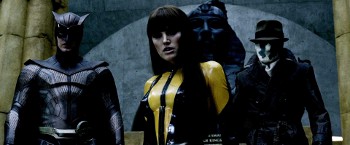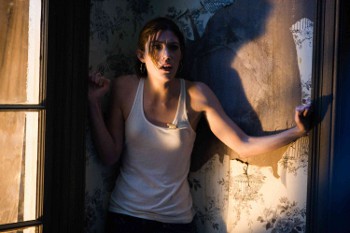Watchmen and Quarantine
 When I say that the filmed version of Watchmen and the horror remake Quarantine are faithful to the point of tedium, I intend that largely as a compliment. Great talent, care, time, and money have been spent not fixing what ain’t broke. Considered separate from their sources, both movies work.
When I say that the filmed version of Watchmen and the horror remake Quarantine are faithful to the point of tedium, I intend that largely as a compliment. Great talent, care, time, and money have been spent not fixing what ain’t broke. Considered separate from their sources, both movies work.
But they’re damned depressing.
One need only flip through Alan Moore’s and Dave Gibbons’ Watchmen to see that director Zack Snyder has re-created the graphic novel rather than interpreted it. (Full disclosure: I’ve done just a little more than flip through Watchmen, and I’ve only seen the 162-minute theatrical cut of the movie.) And it takes only a few minutes to realize that director John Erick Dowdle’s Quarantine has treated the Spanish [Rec] as a holy text – even though the original was released just a year before the remake.
These are, of course, different cases. Watchmen is the more lavish of these slavish works, with a production budget of $130 million compared to Quarantine’s $12 million. And with Watchmen’s place in the comics canon (and its legendary status as “unfilmable”), the movie has the chutzpah of Gus Van Sant’s Psycho, while Quarantine is born of “Americans would love this if it were only in English!” cynicism.
But I saw these films within a few days of each other, and together they drove home a question: Did anybody have fun making these things? And more appropriately for viewers: Can anybody have fun watching them?
The problem with both is that any acquaintance with the original takes the newer version past familiar and predictable to downright boring and unnecessary. Once it’s evident that there will be no meaningful liberties taken with the source material, one is left only to admire the accuracy, as one can marvel at the skill of a forged painting.
If you’ve consumed these movies’ forebears, there is no surprise – not even the littlest meaningful deviation. It’s not just that you know what’s going to happen next, how it’s going to happen, etc.; you’ve literally seen everything in it already.
What’s the point? How much pleasure can one derive from computer-generated Watchmen backgrounds that look just like they did in the graphic novel? When Quarantine is staged and shot exactly like [Rec], and all the same things happen, how can the movie generate terror – its ostensible purpose?
The fidelity of these two pictures also robs their directors and crews of any artistry and joy. They reproduce rather than create. Both Watchmen and Quarantine present significant technical challenges, but they’re merely technical challenges, and their accomplishments are only triumphs of filmmaking problem-solving.
There is, admittedly, some art in the theatrical cut of Watchmen – the lucidity of the condensation that still offers novelistic nuance. (Given the two extended versions of the movie, one can infer that this was largely accomplished in the editing room. Kudos to William Hoy.)
Yet unlike, say, Brian Helgeland’s miraculous hack-and-slash-and-put-it-back-together adaptation of James Ellroy’s also-unfilmable L.A. Confidential, it looks as if Watchmen screenwriters David Hayter and Alex Tse mostly did selective transcription. They prepended a superfluous fight scene onto the graphic novel’s elegant opening, but beyond that … .
The script and storyboards, of course, only provide a starting point, and the execution still offers opportunities for subtlety and grace notes. Alas, Snyder and his crew play it by-the-book – and I mean that in no way figuratively. Malin Åkerman’s straight-across bangs qualify as innovation compared to the rest of the movie.
Patrick Wilson, Jeffrey Dean Morgan, and especially Jackie Earle Haley provide some relief from this oppressive fidelity with their vivid yet enigmatic portrayals, but they’re not adding much beyond the text. And although a soundtrack peppered with cultural icons (Dylan, Cohen, Hendrix) is appropriate for a movie that riffs on shared political history, the song choices are a little too obvious, symptomatic of a lack of creativity. (I did, however, like the use of Philip Glass in telling Dr. Manhattan’s backstory.)
I understand that to many people, Watchmen is gospel, and the filmmakers were rightly afraid of doing anything radical to it. But was it too much to ask for them to do something – anything – to distinguish it from its sacred form? Was there nothing new to mine from the text, no new relevance that emerged since the comics were first published? Given how of-its-time the original Watchmen is – and given how much the global political scene has changed with the collapse of the Soviet Union and the aftermath of the September 11, 2001, terrorist attacks – an update that played with the past two-plus decades of history could have been fascinating.
Unfortunately, it appears that Snyder is allergic to artistic risk. So as strong as his Watchmen is in many ways, it is fundamentally and soul-suckingly safe.
But at least Watchmen can justify replicating the original; Quarantine has no equivalent defense.
 Dowdle does make some minor alterations to the infectious-disease-within-a-confined-space-with-zombie-like-monsters-all-captured-by-a-television-news-camera movie. The remake improves upon [Rec] in precisely one place, by excising the rewind-and-replay bit that disrupts the original’s found-video premise.
Dowdle does make some minor alterations to the infectious-disease-within-a-confined-space-with-zombie-like-monsters-all-captured-by-a-television-news-camera movie. The remake improves upon [Rec] in precisely one place, by excising the rewind-and-replay bit that disrupts the original’s found-video premise.
Other changes subtly diminish the American version. The sound design is more conventional – the screeches from the infected don’t curdle the blood the way they did in the Spanish version – and the choice to make the disease rabies-like was a miscalculation, replacing the chillingly vague with the relatively mundane. Similarly, in the closing scene, [Rec]’s creepily puppet-like creature becomes Quarantine’s really skinny guy in his underwear. Finally, the landing of a body in the apartment-building lobby loses some of its shock by being foregrounded more in Dowdle’s version.
You can tell by my nitpicking that Quarantine isn’t in any significant way different from [Rec]. Dowdle reverently repeats the original’s complicated choreography – necessitated by long takes and a single-camera point-of-view – and dutifully mimics every character, plot point, and key composition, along with much of the dialogue. Like the makers of [Rec], he is a competent, clear visual storyteller given the inherent difficulties created by the aesthetic: lots of darkness, lots of running, lots of shaky camera.
All of that takes a lot of work, and I don’t want to diminish the effort or resources necessary to make a feature film, whether it’s a low-budget horror flick or a long-awaited version of a seminal graphic novel.
But I just can’t get past so much money and labor going into copying things that already existed.

